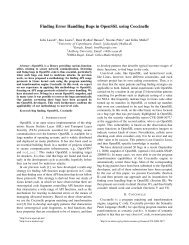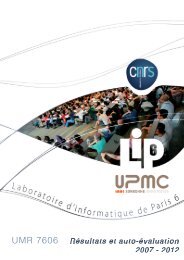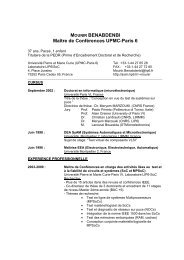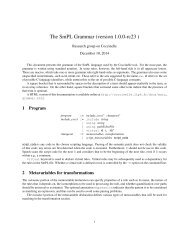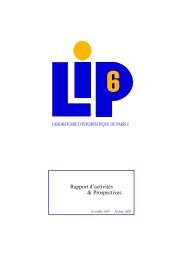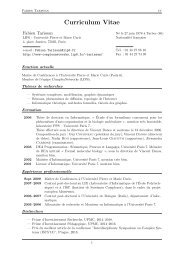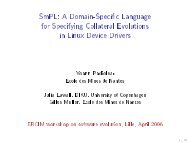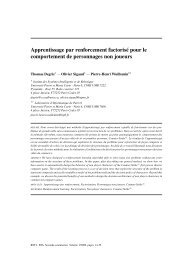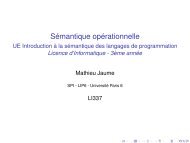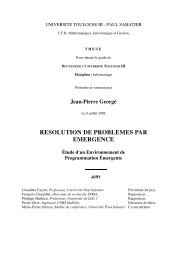Proceedings [PDF] - Measurement and Analysis of P2P Activity ...
Proceedings [PDF] - Measurement and Analysis of P2P Activity ...
Proceedings [PDF] - Measurement and Analysis of P2P Activity ...
You also want an ePaper? Increase the reach of your titles
YUMPU automatically turns print PDFs into web optimized ePapers that Google loves.
International Conference Advances in the <strong>Analysis</strong> <strong>of</strong> Online Paedophile <strong>Activity</strong> Paris, France; 2-3 June, 2009<br />
the other. Taking this perspective focuses attention not on just illegality as a significant quality <strong>of</strong><br />
pictures, but on the preferred type <strong>of</strong> pictures selected by the collector, <strong>and</strong> the value <strong>and</strong> meaning<br />
pictures have to collectors (Taylor <strong>and</strong> Quayle, 2003). In trying to underst<strong>and</strong> the ways in which<br />
children are victimised within the images, Taylor et al., (2001) generated a typology based on an<br />
analysis <strong>of</strong> publicly available images obtained from Newsgroups <strong>and</strong> Websites (made possible under<br />
Irish Law). This ‘COPINE Scale’ had ten levels ranging from indicative images to ones depicting<br />
sadism or bestiality. In 2002, in Engl<strong>and</strong> <strong>and</strong> Wales, the Sentencing Advisory Panel (SAP) published<br />
their advice to the Court <strong>of</strong> Appeal on <strong>of</strong>fences involving child pornography. The SAP believed that<br />
the nature <strong>of</strong> the material should be the key factor in deciding the level <strong>of</strong> sentence, <strong>and</strong> adapted the<br />
COPINE scale to five levels. They dropped levels 1 to 3 completely, arguing that nakedness alone was<br />
not indicative <strong>of</strong> indecency. The proposed structure was therefore that COPINE levels 5 to 6<br />
constitute sentencing level 1 <strong>and</strong> COPINE levels 7 onwards each constitute an individual sentencing<br />
stage (Gillespie, 2003). One consequence <strong>of</strong> using such this measure has been that it provides a means<br />
<strong>of</strong> communication about the images without, for most people, the images ever having been seen. It is<br />
interesting that this way <strong>of</strong> talking about child sexual abuse has also entered into ordinary discourse.<br />
Much earlier work by Lanning (1992) introduced an important distinction between child<br />
pornography (the sexually explicit reproduction <strong>of</strong> a child’s image) <strong>and</strong> child erotica (any material,<br />
relating to children, that serves a sexual purpose for a given individual). In a similar fashion, Tate<br />
(1990 pp 203-217), commented on how the material ranged from, "posed pictures <strong>of</strong> naked <strong>and</strong> semi<br />
naked children, through more explicit shots <strong>of</strong> their genitalia thumbed apart to still, film <strong>and</strong> video<br />
recordings <strong>of</strong> oral, vaginal <strong>and</strong> anal sex". While legal definitions <strong>of</strong> child pornography have to be<br />
objective <strong>and</strong> expressed in terms that allow for the proper application <strong>of</strong> due process, it becomes<br />
apparent that not all <strong>of</strong> the material that is currently circulating on the Internet would meet any legal<br />
definition <strong>of</strong> child pornography, <strong>and</strong> the definition <strong>of</strong> such images as ‘abusive’ is a largely subjective<br />
one. Svedin <strong>and</strong> Back (1996, p9) defined child pornography as, “a text or an image – i.e. photo, slide,<br />
film, video or computer program – that is intended to evoke a sexual feeling, fantasy or response in<br />
adults”. However, expressing criteria in terms <strong>of</strong> a capacity to generate fantasy may be problematic<br />
when objective definitions are required, as the range <strong>of</strong> materials that might evoke fantasy includes<br />
photographs that can be found in any family album or clothes catalogue.<br />
The challenge posed by such a debate is, in the context <strong>of</strong> the huge volume <strong>of</strong> legal, but<br />
sexualised material relating to children on the Internet, as to how we might define these images, <strong>and</strong><br />
whether we should be attempting to control their distribution. Clearly we cannot legislate against<br />
fantasy, but King (2008, p 332) has argued that, ‘It is not clear… that the consumer (or the rest <strong>of</strong><br />
society) can always (or ever) be sure what category a particular image falls into, how much harm to<br />
the subject it represents, for however happy <strong>and</strong> carefree the child seems to be, we cannot know what<br />
later effects she suffered (or, indeed, what she was subjected to after or as a result <strong>of</strong> that photograph).<br />
In fact it’s clear that some degree <strong>of</strong> harm is almost always done to the subject in the production <strong>and</strong><br />
distribution <strong>of</strong> child pornography <strong>of</strong> all kinds…’. King (2008) goes on to suggest that child<br />
pornography not only harms its immediate victims, the children whose abuse is at its centre, but also<br />
harms other children through the actions <strong>and</strong> attitudes <strong>of</strong> its consumers.<br />
One further challenge relates to pseudo (digitally altered) images <strong>and</strong> virtual child<br />
pornography. Gillespie (2003) has raised important issues about how different an image has to be for<br />
it to constitute a pseudo–image, possession <strong>of</strong> which in Engl<strong>and</strong> <strong>and</strong> Wales is likely to attract a lower<br />
sentence. In the US, the constitutionality <strong>of</strong> virtual child pornography remains a critical issue. In<br />
Ashcr<strong>of</strong>t v. Free Speech Coalition (2002) a majority <strong>of</strong> the Supreme Court struck down portions <strong>of</strong> the<br />
Child Pornography Prevention Act <strong>of</strong> 1996, stating that virtual child pornography created without real<br />
or identifiable minors was unconstitutionally overbroad (Quayle, 2008). It might be thought that these<br />
‘pseudo-photographs’ complicate our underst<strong>and</strong>ing <strong>of</strong> the problem <strong>and</strong> challenge our underst<strong>and</strong>ing<br />
<strong>of</strong> harm. Harm, however, need not always be harm towards a specific child. Most legislation against<br />
the distribution <strong>and</strong> possession <strong>of</strong> child abuse images builds on the fact that even unaware victims<br />
somehow come to harm, much in the way described by King (2008), <strong>and</strong> the increased number <strong>of</strong><br />
abusive images in circulation may add to the likelihood that children are seen as possible objects <strong>of</strong><br />
real abuse.<br />
60


![Proceedings [PDF] - Measurement and Analysis of P2P Activity ...](https://img.yumpu.com/32964521/60/500x640/proceedings-pdf-measurement-and-analysis-of-p2p-activity-.jpg)

